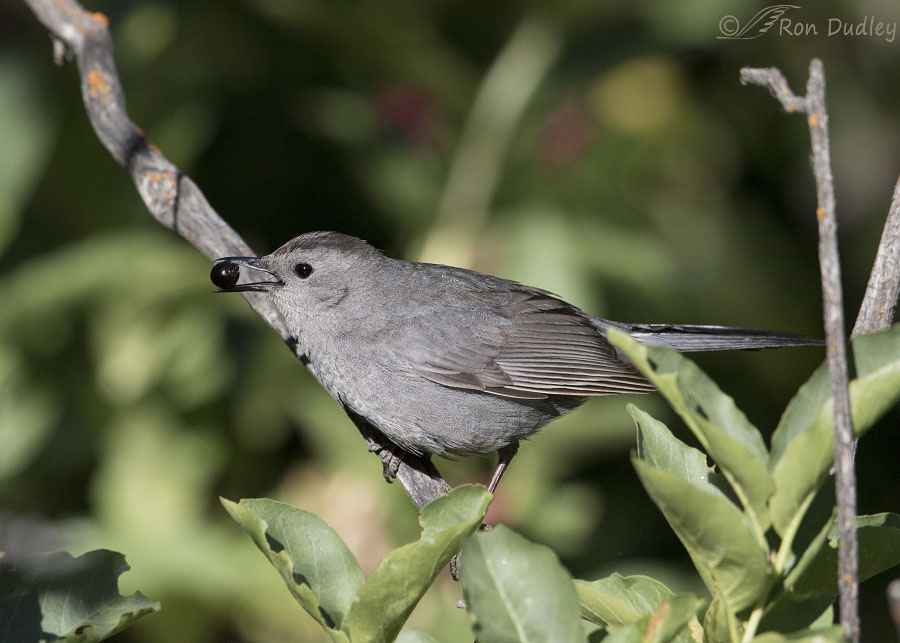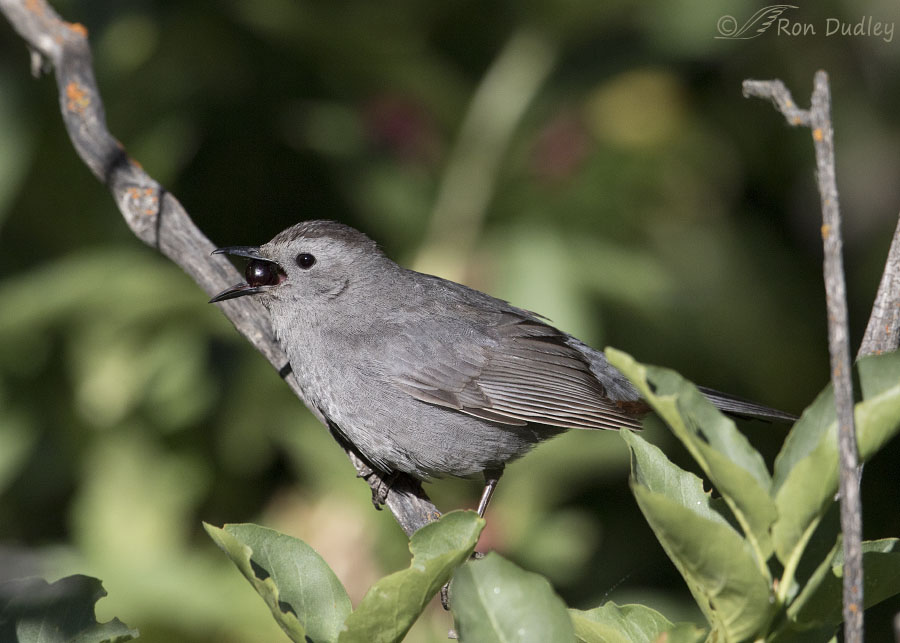I think these berries look luscious. They aren’t…

1/4000, f/6.3, ISO 800, Canon 7D Mark II, Canon EF 500mm f/4L IS II USM + EF 1.4 III Extender, not baited, set up or called in
For the last several weeks I’ve been photographing a variety of songbirds in a Wasatch Mountain canyon – Gray Catbirds among them. These birds are more shy and elusive than most of the rest but they do occasionally grab a berry or two from a Black Twinberry Honeysuckle growing at the bottom of the slope below where I sometimes park my pickup. They dive into the thick foliage where I can’t see them, grab a berry, and then they usually fly off with it immediately or consume it while buried in the bush, leaving my shutter finger still itchy.
But two days ago this one paused for a few moments where I could see it and savored the berry for some time before it swallowed its snack.

1/4000, f/6.3, ISO 800, Canon 7D Mark II, Canon EF 500mm f/4L IS II USM + EF 1.4 III Extender, not baited, set up or called in
Down the hatch.
The Black Twinberry Honeysuckle is a native deciduous shrub found in most of the western US, although it isn’t particularly common. Native Americans used it for a variety of purposes and I think it’s quite attractive, especially with its ripe black berries. Others must agree because it’s sold in nurseries as an ornamental shrub.
The berries are utilized as food by bears and a few bird species and I think they look delicious. In fact more than once when I’ve been starving while photographing here I wanted to walk down the slope to the shrub and raid the berry patch.
It’s a good thing I didn’t because I’ve recently learned that they’re basically inedible because they’re so very bitter. I doubt they’d go well with my chocolate donut.
Ron
PS – If you’re interested here’s a link to a photo of a Black Twinberry Honeysuckle from the US Forest Service with a few of those black-beauty berries still attached, although it looks like many of them have already fallen off or been eaten by some hungry but ill-informed bird photographer….


Lovely photos, Ron! I love catbirds and for the past couple of years there have been a pair nesting in my yard. I guess it is the male that sings his heart out every day. The song is quite varied (I used to think I was hearing a mockingbird until I saw the songster). This year I put out grape jelly to see if Orioles would visit but only the catbird ate the jelly.
Nancy, I had no idea catbirds would go for jelly but I guess I’m not surprised. And yes, catbirds are mimics, much like mockingbirds are.
I’ve never seen or heard a Gray Catbird. Although subtle, I think that their colors are quite attractive. The berry complements the black markings on the bird.
Thanks for being patient and getting these photos for us, Ron.
I’ll keep my eye open for the pickup with a very big lens sticking out the window!
Thanks, Alice. Just look for the HARRIER vanity plates. That’ll be me.
Looked up Harriers. Quite an interesting bird. I’ll look them up with more diligence now that I know about your interest. I have to investigate them as they probably depict a part of your personality; Exciting for me to explore…thanks so much.
We saw one for the first time in our waterfall this morning. We live in eastern North Carolina.
Congrats, Michelle!
What lovely shots! The catchlight on the berry mimics that of the catbird’s eye. Pretty cool!
Sounds like you might need to have a “backup donut” for those long mornings. 😉
Wishing everyone a happy and quiet 4th!
Thanks, Marty. I’d take the “quiet” 4th in a heartbeat but ain’t gonna happen…
How considerate of the grey charmer to give you a photo. And yes, those berries do look lucious. Glad they are for some at least.
EC, some game animals eat the leaves too but not many find them palatable.
The Gray Catbird is very rare here. However, I have tried to eat a Black Twinberry (Lonicera involucrata) growing in my backyard. I didn’t swallow it, but my throat burned for a good time afterward. Very good shrub to attract hummingbirds.
Wow, you’re braver than I am, Lyle. To me they look tempting but not quite tempting enough… 🙂
But then I’m very careful about what I put in my mouth. I won’t even eat a mushroom that didn’t come from a grocery store or restaurant, no matter how safe someone else says it is.
“But then I’m very careful about what I put in my mouth.” I try to be, but all too often, my Size 11s (yes, I have clodhoppers) make it in there when I’m not careful. 😉
You too have paddleboats for feet? Another commonality.
It has been a long time since I saw a catbird, one of the first birds I identified. I was 7 years old and thought there was a kitten in a tree. . .that was Maryland, a long time ago. Catbirds don’t live out here in California. Nice to see one and remember.
I’m glad you enjoyed it, Martha. Thanks.
Two nice images of a subtley-colored magnificent singer…love both,but especially the first…
I like that one best too, Patty – the berry is better positioned to be seen well.
Wonderful shots Ron!
Charlotte
Thanks, Charlotte.
Believe it or not 100 miles or less south of where we live today Catbirds are a “dime a dozen” (old saying, probably not true today). However, here in middle VT they are “few and far between”. it is a big deal here to see a Catbird. These are wonderful shots of a Catbird feasting. Won’t be long before our crab-apples will be ready – looking forward to an Avian incursion.
Thanks, Dick. It may be an old saying but us old guys still say it… 🙂
Beautiful shots of a beautiful bird. I’m hoping to get to see some Gray Catbirds in the next few weeks. They are always fun to watch.
Thank you, Susan. I hope you’re successful.
Grin. Hope that wasn’t personal experience. I can tell you that an u ripe persimmon will make you want to physically peel your puckered lips apart.
I’ve never tried persimmons but I’ve heard about them…
Ron, that astringency happens only with American persimmons, which are sort of acorn-shaped. If you eat Fuyu (Japanese) persimmons, they don’t have the same quality. The American persimmons are fine if you let them get totally squishy soft.
Ron – good morning and Happy 4th of July to all. I don’t ever recall seeing a Black Twinberry Honeysuckle or a Gray Catbird so thanks for the education and the nice photos.
Everett Sanborn, Prescott AZ
Thanks, Everett. Same to you!
Nice capture, Ron! 🙂 I hear them more than see them here – took some time to figure out what was making that “mewing” sound……;) Don’t think I’ve seen that honeysuckle. Know birds love other honeysuckle berries here along with the buffalo berries and chokecherries – not letting the latter ripen this year! Chokecherries being another berry that looks good BUT! Some, including my husband, will eat those off the bush………..
I hear them more than see them too, Judy – far more. And I probably hear them more often than I think I do because their vocal repertoire is so varied.
I certainly agree with shyness…much patience is needed to photograph these birds! A long wait is worth it to catch a flash of that rufous rump though. Love their mewing in the bushes…it’s almost like a game they play…’catch me if you can’. 🙂 For some odd reason that shrub occurs here in Wisconsin and I’ve found it in the UP of Michigan also. Perhaps moved by visiting tribes eons ago.
Very observant, Kathy. I’m impressed. Here’s what the USFS says about that:
Black Twinberry Honeysuckle “also occurs east of the Great Plains in Michigan and Wisconsin, where it is rare and listed as threatened and endangered.”